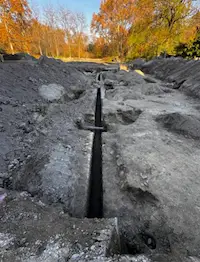|
Pristine Roman Aqueduct Unearthed in Slovakia
March 25, 2025 Archaeologists have found the first-ever unearthed Roman aqueduct in Slovakia. The intact section of waterway had lain undisturbed for centuries. 
The find came during excavations preceding the restoration of a well-known Bratislava relic, the Rusovce Chateau, built in the 19th Century on a site that has since revealed remnants of a 17th-Century church and artifacts dating all the way back to the Bronze Age. Gerulta, a Roman military camp and surrounding settlement, is known to have been in the area. Conducting the excavations are archaeologists from the Department of Classical Archaeology at Trnava University. The team also found remains of an ice house and a brick kiln dating to the Middle Ages. It was the aqueduct, though, that fired the team's attention. Not before in Slovakia have archaeologists found a Roman aqueduct. It is 3 feet tall and 13 inches (or a Roman foot) wide. The base is made up of Roman bricks, and the rest is stone. It was found 31 inches underground. Archaeologists have found 125 feet in length so far. On some of the bricks can still be seen the names of the brickmakers, including Gaius Valerius Constans, who was operating in what is now Austria in the 2nd Century. At that time, what is now Slovakia was part of the Roman province Pannona Superior. On other bricks can be seen paw prints of animals. The Romans used a great network of aqueducts to carry water from far-away places to most famously Rome but also many other settlements. The Romans were careful to build the conduits at a slight downward grade. They made these conduits from brick, concrete, or stone. All materials were cut to fit snugly together. As with the roads, the Romans thought that a straight path was the best path and so sometimes workers would dig tunnels in which to place the aqueduct conduit in order to keep it flowing downhill in a straight line. Archaeologists still don't know the purpose of this recently unearthed aqueduct. The straightforward conclusion is that it led to a bath house in the Roman camp, but no evidence of such a site has been found. |
Social Studies for Kids |
Social Studies for Kids
copyright 2002–2024
David White




